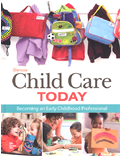
Child Care Today ©2012Chapter 20: Literacy and Language ArtsChapter SummaryLanguage arts includes activities that teach children to listen, speak, read, and write. Emergent literacy is children’s gradual development of literacy skills over time. Rushing language development should not be a goal. Offer opportunities to use language and printed materials in all areas of the classroom. The language arts center promotes language skills. The language arts center should include a library corner, a storytelling area, a writing area, and a computer area. Teach school-age children about Internet safety. Reading aloud to children encourages them to want to read. Good children’s books have simple plots. Think about the interests of each age level when purchasing books. Use dramatic techniques to keep children’s interest while reading aloud. Activities that help children learn to hear similarities and differences in sounds and words include:
Children gradually learn visual discrimination as they begin to read and write. Children must learn to control the writing tool and develop eye-hand coordination to learn to write. Early writers often use invented spelling. The more children write, the more they will want to write accurately. Bilingual children are not at risk for language delays. All children are born capable of learning two or more languages. A bilingual teaching staff is not required for children to learn English, but teachers should work closely with parents of young English language learners. |  |















